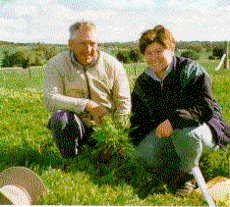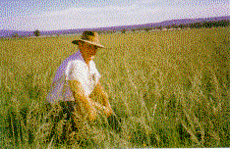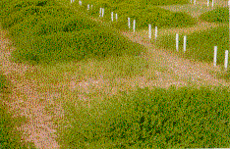
Serradella - Part C Establishing serradella
Sowing time
Autumn sowing is preferred to ensure a strong healthy plant before the start of winter. The later the germination, the greater the risk of poor seed set, or even seed failure, in a dry spring. Generally the best time to sow is from mid-March (for milder environments) until the end of May. In seasons with late breaks, sowing up to the end of June is an acceptable risk, especially in better rainfall areas.
Serradella has established when sown in summer (generally in northern areas). Successful germination generally doesn't occur until autumn or winter. Seed with a reasonably high hard seed content is required for summer sowing. Surface or preferably shallow soil placement is required. It may be necessary to treat the seed with a registered insecticide to prevent seed theft by ants when surface sowing.
Serradella is usually only sown in summer when it is sown with summer growing perennial grasses such as buffel grass. This has been done with good results in conjunction with blade ploughing to remove scrub regrowth.
Survival of rhizobia inoculum appears not to be a problem with summer sowing. Research has shown rhizobia can survive for lengthy periods on serradella seed.
Establishment method
Serradella can be successfully established by a variety of methods, the most appropriate depending on the paddock, available time, equipment, seasonal conditions, vegetation, and soil conditions. Dense productive stands establish more quickly when seed is sown into moist soil and where weed competition is low.
Aerial seeding or broadcasting, while often resulting in slow establishment, (depending on seasonal conditions), is widely practised and sometimes may be the only option. Satisfactory germination usually requires a few days of continuous rainy weather after seeding. Seed may need to be treated to prevent theft by ants. Seed that is aerial or ground spread should always be inoculated. Unlike most other legumes, lime pelleting is not necessary for dry sowing or sowing into acid soil.
When sowing by aerial or ground topdressing, plan and sow early to make full use of the first good rain (which may be the only one).
Direct drilling with appropriate machinery is generally a better method than aerial or ground spreading. Chisel or disc seeding places the seed in a narrow groove and provides ideal conditions for germination and establishment. A press wheel following behind where the seed is placed is often beneficial. On erosion prone soils minimum soil disturbance is preferred.
If weeds or other vegetation are likely to be competitive, a knockdown herbicide applied before seeding is advantageous but not essential. Serradella seedlings can compete with other plants including other pastures, weeds or cover crops. However, the less the competition the better the first season’s seed set. The better the first season’s seed set, the sooner a dense productive pasture develops.
Sowing rate
New sowings of yellow serradella that establish sparsely often take 3 to 5 years to become dense enough to be fully productive pastures. Manipulating several factors including sowing depth, seedbed conditions, sowing time, seed quality and sowing rate can increase initial density. Adding soft seeded pink serradella (e.g. Cadiz) to yellow serradella sowings can help ensure high pasture productivity while the former builds up density.
The better the seed quality and the higher the sowing rate, the quicker serradella stands become fully productive—but also the greater the cost.
If fully productive yellow serradella pastures are required within 1 to 2 years, a sowing rate of 0.5–1 kg/ha of good quality dehulled yellow serradella seed plus 2 kg/ha of pink serradella seed is suggested. At least quadrupling the sowing rate of non treated yellow serradella seed is required to achieve similar plant establishment from sowing treated seed.
Lower seeding rates are acceptable but the trade off is slower establishment and less feed. The highest seeding rates are recommended for ley pastures of 2 to 5 years duration, because it is essential to achieve maximum productivity and maximum input of soil nitrogen for following cereal crops.
Slender serradella (for example Jebala) has much smaller seeds than yellow serradella (1,250,000 compared with 400,000 dehulled seeds/kg) and it is often included with yellow serradella. A sowing rate of 0.25 to 1 kg/ha of slender serradella is suggested if acidic sandy soils prone to waterlogging comprise part of the paddock.
A sowing rate of 1 to 2 kg/ha is recommended in areas where slender serradella is expected to be the principal pasture species.
Higher sowing rates are suggested if seedbed conditions are less than ideal.
Stock (especially cattle) help to spread serradella because some seed remains undigested as it passes through the animal.
Sowing mixtures

Soil type, pH, and associated aluminium and manganese toxicity frequently varies across paddocks. Production from less acid tolerant species, (such as sub clover), is often reduced unless species like serradella are added. This may continue to be the situation even if lime is applied, because subsoils are also commonly acid and lime often takes decades to correct subsoil acidity. The photo shows serradella and sub clover at Baradine. Serradella performed well on this acidic soil without lime application. Sub clover responded dramatically to lime but was unproductive when it was not applied.
Serradella often adds to a traditional sub clover pasture, increasing productivity in spring, especially if the soil is a deep, light loam. Often sub clover prematurely hays off in an early dry spring and fails to recover if following good late spring rains occur. In contrast species like serradella can better withstand the dry period and respond to the improved moisture conditions.
The proportion of serradella needed in the sowing mix varies according to soil type. Usually 0.5 to 1 kg/ha of dehulled serradella seed (2–4 kg/ha enhanced seed) is suggested for a pasture mixture.
In long-established serradella pastures the density of sub clover may gradually increase. Commonly, these paddocks would not grow sub clover before the success of serradella. The reason for this is not clear. Perhaps the added organic matter created by serradella binds some of the toxic soil aluminium, perhaps serradella cycles calcium from the subsoil and deposits it in the soil surface when normal plant desiccation occurs.
Companion perenial grasses
Leaching of water below the root zone is one of the major causes of dryland salinity, of salty water entering river systems, and of soils becoming more acid (nitrogen leaching). Adding a perennial grass or legume should reduce moisture and nutrient loss to groundwater.

Consol lovegrass, Premier digit grass, Rhodes grass and buffel grass grow very successfully with serradella. Buffel grass is proving to be a good companion perennial grass for light soils in drier north-western areas.
Serradella grows in the autumn, winter and spring. Subtropical grasses, such as Consol lovegrass that tolerate high levels of soil aluminium, provide spring, summer and autumn feed, and use the nitrogen fixed by the serradella pasture. An ideal pasture combination on acidic sandy soils is serradella and a summer growing perennial grass such as Consol lovegrass (pictured right). Serradella provides quality autumn, winter and spring feed. Consol provides spring, summer and autumn feed, adds to soil stability, uses the nitrogen fixed by serradella and plays an important role in reducing the rate of increasing soil acidification.
Research indicates that a mixed perennial grass and legume pasture is likely to be environmentally stable. On many sandy soils that are poorly buffered, a summer growing perennial grass combined with a winter growing legume like serradella is likely to reduce or possibly eliminate creeping soil acidification.
The combination of a perennial grass and a legume such as serradella also outcompetes many weeds such as spiny burrgrass (Cenchrus incertus) and blue heliotrope (Heliotropium amplexicaule). Pastures containing a perennial grass are extremely valuable in improving soil structure and combating soil erosion.
Many natural grasses (example redgrass, bluegrass, windmill grass and wallaby grass) are very useful companions to serradella; and provide highly economical pastures for cattle or sheep. However, if paddocks have been sown to pasture following cropping, it can take many years before native perennials revegetate them. Unfortunately there is generally little or no seed of suitable native perennials commercially available.
Sowing depth
Because its seed is small and only germinates successfully from shallow sowing, sow serradella seed no deeper than 2 cm and preferably only 1 cm.
In conventional sowing, seed drops from the small seedbox through tubes that place it behind the last row of tynes on the combine. The following covering harrows cover the seed with soil, however commonly much of it is buried too deep.
Band seeders (when they are properly adjusted behind a combine) ensure a more precise depth of sowing, and therefore better germination and establishment (see Agfact P2.E.1 Band seeders for pasture establishment). A cruder and cheaper alternative is to drop seed behind a levelling bar. The bar is hitched to trail behind the last row of combine tynes. Light trailing harrows then follow.
Furrow sowing is another sowing method that has proved successful. It is important that the furrows follow the contour on sloping country. Harrows should not be used when furrow sowing.
When direct drilling into undisturbed grasslands with a narrow tyned implement, such as a chisel seeder or a triple disc, ensure that the seed is not covered by too much soil. This can especially occur when the soil is too dry. It may be advisable to delay sowing until after a rain event.
Consolidation using press wheels or a roller is often worthwhile if the seedbeds are loose and moisture is marginal. Press wheels are often more appropriate than rollers, especially in direct drill and furrow sowing situations. Be wary of using rollers in country prone to crusting.
Inoculation

Inoculation with appropriate rhizobia is essential. The second plot from the front of the photo is poorly inoculated.
When serradella is sown for the first time in a paddock the seed must be inoculated with group G strain of rhizobia bacteria to ensure effective nodulation (for the correct procedure see Agfact P2.2.7 Inoculating and pelleting pasture legume seed). The naturalised rhizobia bacteria in most soils are usually ineffective for colonising serradella. It is important to follow inoculation directions carefully, and to use an appropriate sticking agent such as methyl cellulose.
It is desirable to lime coat inoculated serradella seed.
A paddock sown with lupins, or a previous serradella pasture, should successfully nodulate a serradella pasture sown up to 4 years later (for example after a 4 year cropping phase).

